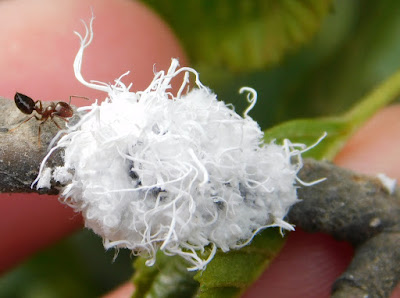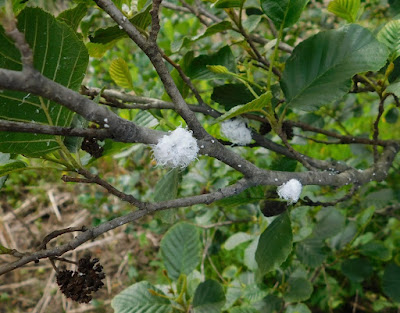Continuing my little series sharing some of the insects I photographed this year, grouping them by order (or whatever, as the case may be). In this case, yeah, order: Hemiptera, the true bugs.
First, a fascinating species that I don’t think we have here in Missouri: the woolly alder aphid; Prociphilus tessellatus. I saw these at a reclaimed wetlands in Virginia on June 12. There are a ton of videos about these weird aphids. I shared links to four of these videos in the preceding sentence. If you click on any or all of them, you’ll enjoy. Incredibly interesting behavior. In my one photo, note the attending ant.
Also, that same day in Virginia, at the same community wetlands, I found a colony of dogwood spittlebugs (Clastoptera proteus) drinking and hopping around on a bunch of native viburnums (I’m pretty sure that’s what those shrubs were). These were the adult spittlebugs, so they were no longer living in a mass of spittle. Instead, they were having a grand time drinking sap and hopping around in the sunshine on the leaves of an entire colony of acceptable food plants. There were, of course, plenty of birds hanging around, too, which no doubt abruptly ended the fun for many, many of these spittlebugs. Because this, my friends, is what bird food looks like.
About a month later, we noticed several colorful leafhoppers on our baby sapodilla tree. (We grew our little tropical sapodilla from a seed within a fruit we bought at Robert Is Here!)
One of the most memorable things I read about leafhoppers this year was someone likened them to speedboats. And yes, they do look like speedboats! Sleek and slender, with spiffy colors and markings—wow! The only thing is, you have to look carefully at them to appreciate them, because they’re tiny.
Did you know that leafhoppers cover themselves with wax? Sometimes you can see a little white oval spot on the second half of their bodies, which is kind of a reservoir of waxy-stuff. They use their little comblike serrations on their legs to wipe the waxy stuff over their bodies. The wax helps to repel water, and maybe even more importantly, it helps repel the sticky excretions that come out of their friends, relatives, and neighbors after they feed so heavily on sweet plant sap.
This particular miniature speedboat is Graphocephala versuta. You could call it the “cunning sharpshooter,” because versutus is Latin for “cunning” and Graphocephala members are in a leafhopper subfamily called sharpshooters.
One of my projects this year was adding to the true bugs on MDC’s online field guide. You can see them all here.










No comments:
Post a Comment